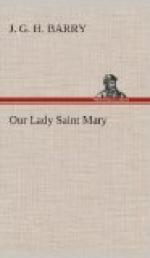case was a wonderful one, for both Jesus and Mary
were there. It was therefore the ideal of all
weddings which seem to lack the true note of the new
matrimony which springs from the Incarnation if they
take place without such guests. As in imagination
we follow Mary as she goes quietly about the house,
which like her own was a home of the poor, helping
in the arrangements of the wedding, one cannot help
recalling many weddings with which one has had something
to do, and in the arrangements of which we cannot think
of Mary as having any part. They were the arrangements
of the weddings of Christians, and the weddings took
place in a Christian church; but neither is Mary there
nor Jesus called. We are unable to think of Mary
as present amid the tumult of worldiness and frivolity,
the endless chatter over dress and decoration, which
so commonly precedes the celebration of a sacrament
which is the symbol of “the mystical union that
there is betwixt Christ and His Church.”
That deep piety which puts God and God’s will
before all else would strike a jarring note here,
where the dominant note is still the pagan note of
the decking of the slave for her new master.
It is perhaps not without significance of the direction
of the movement of the modern mind that the protests
of the emancipated woman are against the Christian,
not the pagan elements in matrimony: she tends
to regard marriage as a state of temporary luxury
rather than the perfect union of two souls in Christ.
Clearly in marriages which are regarded as purely
temporary engagements, dependent on the will of the
parties for their continuance, there is no place for
the mother of Jesus. The purity that emanates
from her will be a silent but keenly felt criticism
on the whole conception underlying a vast number of
modern marriages. Even as I write I read that
in a certain great city in the United States the number
of divorces granted was one fourth of the number of
the marriages celebrated.
Clearly at marriages which are surrounded with this
atmosphere of paganism, be they celebrated where they
may, there is no place for the Blessed Mother; and
neither is Jesus called. His priest, unfortunately,
is often called, and dares celebrate a sacrament which
in the circumstances he can hardly help feeling is
a sacrilege. There are many cases in which what
purports to be Christian marriage is between those
who are not Christians, or of whom only one is a Christian
in any complete sense. One hears frequently of
the sacrament of matrimony being celebrated when only
one of the parties is baptised. It is of course
possible for any priest to act on the authority conferred
upon him by the state and in his capacity as a state
official perform marriages between those whom the
state authorises to be married: but why do it
under the character of a priest? or why throw about
the ceremony the suggestions of a sacrament?




